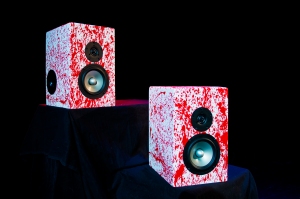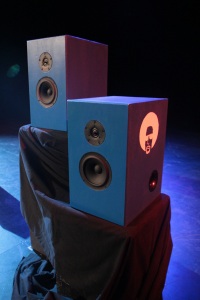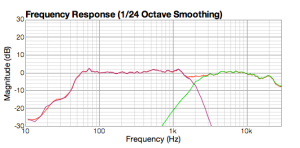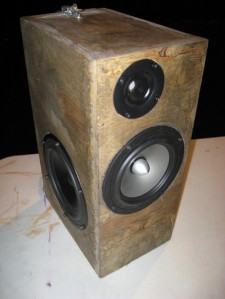Archive
The Copperheads




The Copperheads are a 2.5 way tower speaker system that are a multiuser speaker system for movies, mixing and more. These may not be the best speakers on the planet but with the parallel wiring design and large cabinet the build process taught me a lot about speaker building.
The Dark Passengers – 2 Way Ported Nearfields
Designed and constructed by Andrew Villa
Design Goals
- Portable
- Accurate Response
- Hi-Fidelity for creating/mixing SFX, Dialogue, and music
- Tight transients
- Good horizontal Off-axis
- Dexter Themed
- Used as Nearfield monitors
Key Features
- Small size: 12 1/4″ x 10 1/4″ x 16 1/4″
- +/- 1.6 dB from 80 – 20 kHz
- Vented Enclosure = decent bass for small near fields
- Cost $400
- F3 of 72 Hz
- Tight, precise sound
- Great Clarity
- Unique paint design
Drivers
- Fountek FW168 6.5″ Aluminum Cone Woofer
- Vifa XT25TG30-04 1″ Ring Radiator Tweeter
Testing Results
Overall Frequency Response:
Integrated Frequency Response:

Purple: Tweeter, Yellow: Woofer, Blue: Overall Sum
Impulse response:
Documentation
Griff ’91
Design and Constructed By:
Collin Doerr-Newton
Design Goals
- Portability
- Accurate response
- Good bass extension
- Be pleasant to listen to
- Under $700
Key Features
- Medium size (LxWxH= 16″x12″x20″)
- F3 of about 50Hz
- +/- 2dB response
- Big open sound
- Well under $700
Drivers
- SBAcoustics SB17NRXC35-8 woofer
- Vifa XT25TG30-04 tweeter
Chosen Testing Results
Integrated Frequency Response
Horizontal Off-Axis Response
Documentation
Monitor 1 by Keith Kinnear
High Performance Studio Monitors
The main objective of this design was simply to create the most accurate, high precision studio monitors possible. The speakers were able to meet that objective in almost every way thanks to some key components of the design.
One of the most influential aspects is the cabinet construction, including the unique six-sided shape and complicated panel and joint structures. They help these speakers avoid a whole host of problems traditional box designs usually have to deal with. Panel vibrations, internal cabinet standing wave resonances, and most of the effects of edge diffraction did not pose a problem with these speakers in the least.
An equally important element of the design was the choice of high quality transducers – and believe me, no expense was spared when it came to choosing the right drivers to fit the design criteria. Both the tweeters and woofers are low distortion, high bandwidth drivers that are known for their smooth, un-colored sound. Both of them are also great performers and made it easy to implement them into this, and likely almost any other, design.
The crossover is the last piece of the puzzle to be mentioned since it connects everything together and literally shapes the sound of the signal being presented to the drivers. Many hours of testing and very careful manipulation of the passive circuit elements produced a crossover that reacts with the drivers in such a way that the on-axis frequency response only varies by 2 dB across a spectrum from 50 Hz to 18 kHz. Now that’s something that anyone can be proud of.
In all, the design was a success and the speakers have proven to do exactly what they were designed for – be highly accurate, high performance studio monitors.

Monitor 1 by Keith Kinnear is licensed under a Creative Commons Attribution-Noncommercial-Share Alike 3.0 United States License.
 Design Objectives
Design Objectives
- Highly accurate studio monitors for precision mixing and mastering
- Relatively low crossover point to preserve vocal presence range
- At least 103 dB SPL max output
- f3 = 45Hz
Key Features
- Full range two-way design made possible by the use of wide bandwidth, low distortion drivers
- Unique cabinet shape and construction designed to eliminate many of the common diffraction, vibration, and resonance problems found in traditional box designs
- Exceptionally flat frequency response from 50Hz to 18 kHz
- Excellent impulse and step (time domain) responses, indicating a lack of time smearing and greatly improved clarity and transient accuracy
- Outstanding horizontal off-axis response
- Sturdy handles on the sides to make movement possible
System Tests
Tweeter Tests – Scanspeak D3004/6600-00 AirCirc
Woofer Tests – Seas L22RN4X/P H1208
Green Run: Critical Editing Speakers
What they lack in size they make up in clarity and versatility. Designed for
near-field desktop audio editing, these speakers are created to
reproduce the sound signal with maximum clarity. Optimized and built
small to fit at any editing environment and portable for the nomad
lifestyle.
Design Objectives:
- Bookshelf monitors for audio editing for music, sound effects and film
- Wide frequency range (60 Hz to 20 kHz)
- Smooth frequency response
- Inexpensive
Key Features:
- Small, and portable
- Clear stereo image
- Minimal off-axis coloration
- Low crossover frequency of 1.5kHz
- Under $500
System Response
Final System Response Charts Left Cabinet
Final System Response Charts Right Cabinet
SB Acoustics 29RDCN C-0004
Final Tweeter Response Charts Left Cabinet
Final Tweeter Response Charts Right Cabinet
Fountek FW 146
Final Woofer Response Chart Left Cabinet
Final Woofer Response Chart Right Cabinet

This work is licensed under a Creative Commons Attribution-No Derivative Works 3.0 United States License.





























